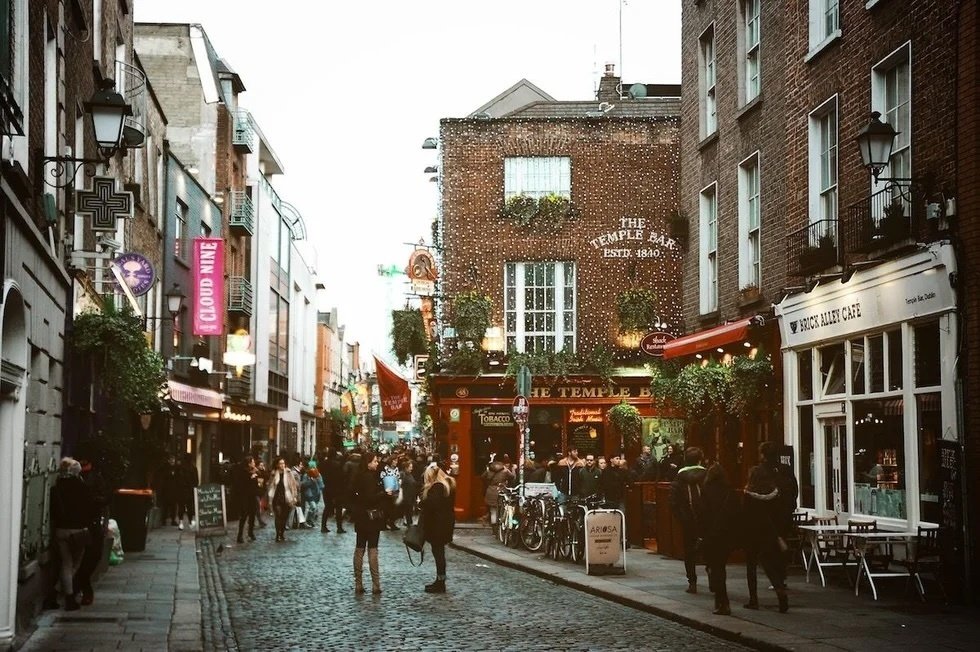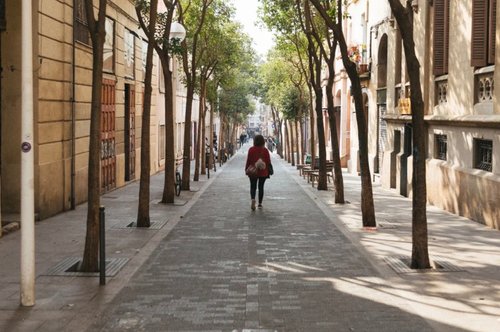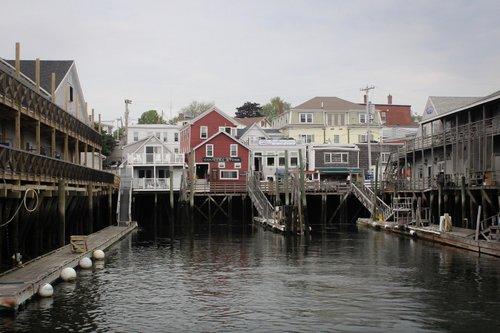Fancy moving to Dublin, Ireland to work? Here’s what you can expect
16. 4. 2024
10 min.


Journalist
No one moves to Ireland for the weather—unless they’re keen to wander under silvery skies and feel a mist as soft as tears land on their face. This small island on the edge of the Atlantic Ocean is chilly and windswept at the best of times, but the people have built a reputation for being warm and friendly. The capital regularly tops the charts of the friendliest cities in the world. Not all Irish people are as charming as Cillian Murphy, Saoirse Ronan, and Paul Mescal but most are happy to chat with strangers, whether at a bus stop, across a hedge, or in the pub. It’s an easy city to make yourself at home and even those who don’t appreciate the Irish attachment to humor will get a warm welcome. So if you like the idea of working in Dublin read on for some tips on how to make yours a smooth transition.
Exploring Dublin: Urban life and nature escapes
Ireland’s capital is perfectly positioned for anyone who wants to enjoy all that a modern urban center has to offer while staying in touch with nature. Dublin, a leafy, low-rise walkable city straddling the River Liffey, has museums, galleries, and pubs galore to keep you amused on rainy days. For all other times, there are beaches stretching the length of Dublin Bay to explore, and the Wicklow and Dublin mountains are within easy reach with handy hiking trails. Europe’s largest city park, the 1,750-acre Phoenix Park which opened in 1747, has everything from pre-historic burial chambers to pretty lakeside picnic spots (as well as the US ambassador’s residence). If that isn’t enough, the west coast—a prime stretch for surfing spots—is just a few hours away by car, and Belfast, with its Titanic Quarter, is a couple of hours away by train.
While famed for its creamy Guinness, literary talent, and witty locals, Dublin is also home to some of the world’s biggest tech companies in the world. Giants such as Google, Meta, Facebook, Twitter, LinkedIn, and Hubspot have their European headquarters here. Low corporate tax rates and an educated, English-speaking population have helped to create the tech hub that previous governments dreamt up back when Ireland was an agricultural economy.
A European tech hub
Despite recent rounds of layoffs, tech employs about 121,000 people directly, making it one of the biggest sectors in the State, alongside construction, and education. The population of the Republic of Ireland has been creeping up and now exceeds five million—for the first time since 1853—putting it on a par with Alabama. If you add in Northern Ireland, the northeastern corner of the island which is ruled by Britain, the total is closer to seven million. Even though the unemployment rate edged up slightly to 4.5.% in January 2024, an estimated 2,643,000 persons were in employment at the end of 2023, up 3.5% on the previous quarter. Most of those workers are on the east coast as the greater Dublin area holds about 40% of the country’s people.
Salaries in Ireland tend to be lower than in the United States, though those who are lucky enough to be transferred by their American employer can expect to be paid more. Average weekly earnings were about €922 in all sectors at the end of 2023, adding up to an annual pre-tax income of about €45,000.
Starting salaries for most professionals are about €30,000 to €35,000. Those with three to five years of experience can expect substantially more. For example, a digital marketing executive can expect €40,000 to €45,000; a mechanical engineer €50,000 to €60,000; a web content manager €60,000 to €70,000; and a software engineer can expect to earn from €50,000 to €70,000. Many roles offer €70,000 to €100,000 or more after five to 10 years.
Mary O’Neill, a data architect with more than 10 years of experience in the United States, says, “Forget about getting the same money as in the US. Rates are lower. Specialized skills are more sought after and more valued in the US.”
Where to live
Unfortunately, that doesn’t mean that accommodation is cheap. There is a housing crisis at the moment and so that means the average rent for new tenancies in Dublin in late 2023 was €2,113. For that, you might get nothing more than a 300sq ft/28sq meter studio—and that’s if you can find a place.
The best value, whether in rentals or restaurants, is often to be found north of the Liffey on the Northside. Both Stoneybatter and Smithfield have received accolades for being among the coolest neighborhoods in the world. But the leafiest areas are mostly to be found on the Southside in Sandymount, Rathmines, and Rathgar. Perhaps thanks to its proximity to the George on South Great George’s Street—Dublin’s oldest gay bar—the Liberties in Dublin 8 is popular with LGBTQ singles, couples, and throuples.
The most popular websites for finding accommodation are Daft.ie and MyHome.ie. Be prepared to show evidence of funds in a bank account and to have references from a previous landlord or employer. A deposit equivalent to one month’s rent is collected usually in addition to paying the first month’s rent in advance. At busy times of the year, particularly in September when students are looking for accommodation in this university city, you may even have to queue just to be allowed to view the property.
A drop of Irish is just enough
Irish, aka Gaeilge, is the official first language of Ireland, though not many people speak it fluently, so being fluent in English, the second official language, is what matters. Irish is popular with the government and companies when naming departments or businesses. Hence, the police force is An Garda Síochána (Guardians of the Peace), commonly known as the Guards, Bord Bia is the food board and Fáilte Ireland is the National Tourism Development Authority, as Fáilte means welcome.
Rather than trying to learn Gaeilge, it’s more important to tune into Hiberno-English. In British English, for example, ’grand’ means impressive. In Hiberno-English, ‘That’s grand’ can mean ‘okay’, ‘wonderful’, ‘Don’t worry about it’, or even ‘What were you thinking, you idiot!’ It all depends on context and body language. Likewise, if you’re telling a funny anecdote and someone shouts ‘Stop’ or ‘Go away’, don’t stop and don’t reach for your coat. That’s the Irish way of saying, ‘Tell me more!’ Again, it all depends on context and usage.
Oddly, the use of coarse language—including a variety of expletives—is common and should not be taken personally. “They don’t mean anything bad by it,” says O’Neill. So, for example, if you hear of someone being described as a ‘mad bastard’ that might not be intended to be an insult—it might even be a compliment given the admiration held for rebels and cheeky chappies (yes, we do mean Barry Keoghan). This is true not just in social situations, but in some workplaces. It wouldn’t be wise to try joining in, though, as it can be hard for those unpractised in this art to get it right.
At the same time, being too direct in speech can be seen as rude, which can lead to some unnecessarily long conversations—this is where the Irish depart dramatically from the British. Boasting is treated with suspicion. People don’t like to say no either, so they may say ‘yes’ rather than risk offending you with a rejection, even if they really don’t think they can oblige. This can apply to party invitations as well as work commitments, leading to some confusing situations. Likewise, they may ‘no’, when they really want to say ‘yes’, such as when you offer to buy them a drink or if you offer to help them out on a project. Comedians like Aoife Dunne and Bernard O’Shea delight in highlighting this behavior.
Getting around the city
Manners are important and Dubliners take pride in always saying ‘Hello’ to the bus driver when getting on the bus and ‘Thank you’ when leaving. Hopping onto a double-decker Dublin Bus is a popular way to get around, especially if you use a Transport for Ireland (TFI) Leap card. You can load up to €150 onto the card and tap it when you get on the bus. Fares can be up to 30% cheaper than buying single tickets. You can top it up using the TFI Leap app and then plan your journey around the city using the TFI live app. The average journey costs €2. The card can be used on public transport services including Dublin Bus, Go-Ahead Ireland buses, the Luas tram service, the Dart electric rail service that runs along the coastline, and some commuter rail trips. There are booths and machines at many stations selling tickets. The Leap card can also be used on the Aircoach to the airport, some private bus routes, and the Nitelink, which runs from midnight to 4am instead of regular buses, which start up again at about 5.30am. There is no subway system in Dublin, so buses, trains, and trams will be your best friends.
Walking is also a great way to get around town, not just because you can appreciate the elegant 18th- and 19th-century architecture, but because you will avoid being left in the cold by a ghost bus. At bus stops, a backlit display lists how many minutes until the bus arrives. A ghost bus is one that’s listed as getting closer and closer before it disappears. Sometimes, it has swished past your stop early. Sometimes, it turns up 10 minutes late when you’ve decided to walk instead. Sometimes, it never appears at all—and that is a true ghost bus.
This partly explains why, despite the damp climate, cycling has become increasingly popular—that and the traffic congestion. Many choose to use Dublin Bikes, a bike rental scheme, to get around. There are a few payment options, but the most popular with locals is to pay a yearly subscription of €35. Then the first 30 minutes are free, after which you’ll be charged based on the length of your journey. Other options include Bleeper, which offers a monthly pass with unlimited one-hour trips for €17.50, and Moby electric bikes, which cost €79 a month.
Taxis can be hailed on the street or at a rank, though most people use the Lynk, FreeNow, or Uber apps to book a car. Note that Uber operates in Dublin as a taxi service, not a ride-sharing app. Locals can also rent a GoCar for €9 per hour or €54 a day.
Being allowed to work
Americans can visit Ireland for 90 days on holidays or business without getting a visa first, though there’s no guarantee you’ll be admitted. To be allowed to work in Ireland takes more effort. Most Americans require an employment permit. There are a number of types of permits, including critical skills and internship, so it’s worth investigating which one suits your situation. In general, you’ll need to have an employment permit before you arrive in the country. You can apply for an employment permit once you have been offered a job. This means that you have to find a job and then apply for an employment permit. Ideally, your employer can help you with that.
Of course, you will likely be part of a cosmopolitan workforce. Although just 12% of the population don’t have an Irish passport, it’s obvious when you walk the streets that there are people from all over the world and they’re not just tourists. Over the years, people from 180 countries around the world, including the US, have been naturalized.
Like their American counterparts, many Irish workers who could work remotely decamped to the countryside during the pandemic. Most of the jobs are still in the Dublin area, however. Just south of the river Liffey, an old docklands area is now known as the “Silicon Docks” thanks to the prevalence of social media and other tech companies. Just across the river, the International Financial Services Centre is home to more than 400 banks, insurance companies, and other financial institutions.
What it’s like in an Irish office
American companies here operate much like they do in the US, with the same structures and expectations. Irish company culture tends to be different, according to O’Neill, who has worked for pharma and tech companies in both countries. There is more formality in US companies. “In the US, meetings are more structured,” she says. “People tend to be more serious and better prepared. They wait for their turn to speak. They follow an agenda and someone takes minutes.” In Ireland, meetings tend to be more freeflow. “I like the ease of Irish communication,” she says. “There is more casual conversation in meetings, which I like. But there are advantages to both approaches.”
When it comes to projects, there is a lack of planning in Ireland. “They want to get on with the job, rather than following a schedule,” she says. The exception to this was when O’Neill worked for Icon, a billion-dollar clinical research behemoth. “Icon was very structured and organized,” she says. “Other Irish companies pay lip service to this idea, but many of them are not great at it. They fly by the seat of their pants.”
The working day
The 40-hour week is standard and most people put in eight hours a day from 9am to 5.30pm with half an hour to an hour for lunch. Some manufacturing facilities take a half-day on Friday and country-wide the average number of paid hours in 2023 was 33. For most roles, the maximum number of hours you can be asked to work is 48. There is no legal right to paid overtime, but many employers do offer it.
Most employees get at least four weeks or 20 working days of paid vacation a year, though it’s not unusual for professionals to get six weeks off. There are also 10 public holidays, also called bank holidays, up by one since 2023 when St Brigid’s Day was added to honor both the saint and the goddess of the same name who preceded her—at least, that’s how it has worked out. Good Friday is not a public holiday, but most companies give their staff the day off.
An easy way to make friends is to take up a sport. It’s a rare Irish person who isn’t keen on watching or playing sports such as rugby, football, or Gaelic football, which is a bit like a cross between the first two, or hurling, a violent precursor to field hockey. New players and volunteers are welcome. Or, you can go to the spectacular Croke Park, stand in the rain, and cheer on the Dubs like a local.
Working in Dublin: Key takeaways
Relocating to Dublin offers a unique blend of cultural richness, vibrant city life, and natural beauty. Whether you’re drawn by its friendly atmosphere or the booming tech scene, here’s what you should keep in mind as you plan your move:
- The city is home to a friendly and welcoming atmosphere: Dublin is frequently ranked as one of the friendliest cities in the world, making it easy for newcomers to feel at home and build new connections.
- It’s a European tech hub: Home to the European headquarters of major tech giants, Dublin offers abundant opportunities in the tech sector, supported by a favorable corporate tax environment and a skilled, English-speaking workforce.
- Enjoy city life with easy access to nature: Despite its urban setting, Dublin offers easy access to beaches, mountains, and Europe’s largest city park, providing a perfect balance for nature lovers.
- History and culture lovers are in for a treat: From its literary heritage to historic sites and dynamic social scene, Dublin boasts a rich cultural tapestry that enriches daily life.
Embracing life in Dublin means diving into an environment where history, modernity, and nature intersect seamlessly. Whether you’re advancing your career in the tech industry or seeking a friendly urban atmosphere, Dublin offers a compelling backdrop to forge a fulfilling life and career.
Photo: Welcome to the Jungle
Follow Welcome to the Jungle on Facebook, LinkedIn, and Instagram, and subscribe to our newsletter to get our latest articles every week!

Viac inšpirácie: Práca v zahraničí

Moving to NYC for work? Here's what you need to consider
What is the reality of living and working in The Big Apple? The truth has to lie somewhere between Sex and the City and Taxi Driver.
10. 1. 2024

Fact or fiction: graduate programs in Europe are worth it
As soaring US tuition cost has caused a debt crisis, Americans are turning their eyes to graduate schools in Europe...
12. 4. 2023

The 2023 guide to living and working in Portland, Maine
As the cost of living in East-Coast naves like Boston and New York keeps rising, Portland is emerging as a top choice for big-city defectors.
21. 3. 2023

Moving to the country in a post-pandemic world
As remote and flexible work edges toward ubiquity, roughly half of Americans would already prefer a rural area to a city or suburb
13. 2. 2023

Working in Chicago
Thinking about relocating to the Windy City? Two residents share their experience and insights
07. 12. 2022
Novinky, ktoré to vyriešia
Chcete držať krok s najnovšími článkami? Dvakrát týždenne môžete do svojej poštovej schránky dostávať zaujímavé príbehy, ponuky na práce a ďalšie tipy.

Hľadáte svoju ďalšiu pracovnú príležitosť?
Viac ako 200 000 kandidátov našlo prácu s Welcome to the Jungle
Preskúmať pracovné miesta